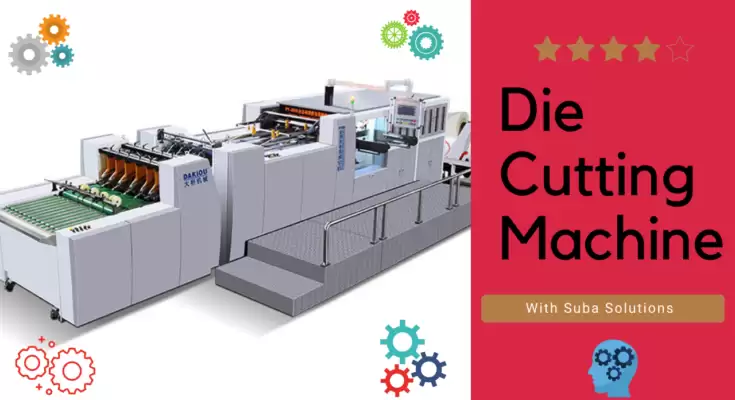Introduction
The process where the die is used to cut the materials like paper, cardboard, cork sheet, or any other fragile hard material is called die cutting.
Die cutting is widely used to cut scrapbooking, journaling, cardmaking, and other cuttings too.
The object is positioned so that the blade and the die are properly aligned and the strong backing is constructed into a predetermined form to cut the shapes and patterns.
In order to cut the appropriate forms in the substance, the installed steel blades are forced onto the substance. The steel blade now cuts based on the required shapes.
Now let us look into the advantages of die cutting, and following that, let us look into the types of die cutting.
Advantages of Die Cutting:
There are “N” a number of benefits of die cutting. Let us look into it now!
- Die-cutting is eco-friendly and requires less amount of time only.
- Using dye cutting, one can make different shapes as per individual wish.
- With a single punch, you can make many complex shapes.
- Die-cutting enables the creation of beautiful forms and folds in cards and plastic.
These are the advantages of die-cutting. Now let us look into the types of die cutting.
Types of die cutting
There are many types of die cutting; let us look into the top die cutting that many people use. Different die cutters are used for various purposes. Different dye-cutting methods are available, but the purpose of die-cutting is neutral; they die and cut. The Automatic die-cutting with a stripping machine is one such machine that Suba Solutions specializes in. Now let us look into the different types of die cutting in the following lines. We will be looking into the gist of Laser type die cutting, flatbed-type die cutting, water jet-type die cutting, blanking die cutting, and steel rule dye cutting.
Laser-type die cutting:
Laser-type die cutting is widely used in many places as using them provides speed and accuracy. The non-thermal ray is made to cut the non-metallic elastomers. All other die cutting uses the dye, but the laser type does not use the die to cut.
Heavy metals and other unmanageable objects require laser-type cutting. Laser-type die cutting is used everywhere as they are versatile, suitable for any type of production, and process completed in the appropriate time.
Flatbed type die cutting:
This type of die cutting uses hydraulic pressure to ensure they are cut into different shapes with a steel rule die. Many use flatbed type die cutting as they are low cost for tooling, have flexibility in designing, has a strong cutting blade ensuring they can cut any harder or larger objects within a period.
Flatbed types of die-cutting machines could be perfect if your project calls for a variety of shapes or if there is no need for material deformation. In particular, flatbed types of die-cutting machines are more affordable when producing low-volume orders.
Water Jet type die cutting:
As the name indicates, this water jet-type die-cutting uses highly pressurized water. This means using the forced water, the materials are cut. While cutting, the sound is thrice the sound of normal water. The laser-type die-cutting water jet type die cutting does not use a die for cutting.
This torrent of water, which is delivered through a minuscule aperture, has the strength to cut through a variety of materials, including steel. A very precise and adaptable cold-cutting technique, water jet die cutting often have low maintenance expenses.
Die-cutting machines with laser jet technology are frequently employed in industrial processes where accuracy is essential.
Blanking Die cutting:
Just like the rotary die, the blanking die cut uses the same procedure, but instead of the cylindrical dies, they use a flat blade that cuts against various shapes.
This blanking die cutting is used for large-volume orders and minute cutting. In addition, the blanking die can be utilized if you possess any thick or stronger material.
Often constructed of steel or another hard metal, the blade used in blanking die cutting has a sharp edge that easily cuts through the material.
Steel rule Die Cutting:
Steel blades are bent into precise forms and pressed against the material in steel rule die cutting to create unique patterns or designs.
The majority of the time, complex details like those seen on textile or cloth products like wallets, purses, shoes, belts, etc., are produced in large quantities using this form of die-cutting.
Since it’s simple to alter the blades for a different design easily, it’s also excellent for producing samples or one-of-a-kind items.
These are different kinds of die-cutting used for different purposes. Apart from this, there are other cuttings that include kiss cutting, perforating, scoring, creasing, and through cutting. For other cutting procedures, enquire about well-qualified professionals and other buyers about the usage of the product and the industry firm where you are going to buy the machine.
Conclusion
Hope by reading the entire article, you have got a clear idea of how to die cutters works and the unique benefits of die cutter.
Suba Solutions provides high-quality automation and packing-related products to improve your business.
With over 10+ years of experience in trading and manufacturing, we have well-trained professionals who ensure the products are well-made and revised before sending them to the customers.








